Fertilising hedge plants: to fertilise or not to fertilise?
To fertilise or not to fertilise hedge plants? That’s one of the question our customers ask us. The answer is: fertilising your hedge is a must. Why fertilise? Which fertiliser do I use? How much? How often? When and how? It’s not difficult. No need to worry! Read this blog and you'll know exactly what to do. Promised.
Why should you fertilise your hedge plants?
Your hedge needs nutrients to grow and protect itself against mould, disease and pests. You will have to add the nutrients yourself; the plants don't just get it from the ground. So it's safe to say that fertilising is just as important as watering and pruning.
An additional advantage of fertilising is that the roots do not look for nutrients elsewhere in the garden. Because if they don't get the right nutrients, they might overgrow the neighbouring border. You want the roots to stay in place as much as possible. Fertilising helps with that too. The roots get what they want and stay right where they are.
What kind of fertiliser to use for the hedge?
You can choose between two kinds of fertiliser: artificial fertiliser and organic fertiliser. We recommend organic fertiliser. It's better for the environment and it’s slowly released to your hedge plants over a longer period of time. With artificial fertiliser, the hedge plant gets all the nutrition it needs at once. This is not good for the plants and, if it rains, all the nutrients are washed into the ground before the plants have absorbed them.
Organic fertiliser comes in several varieties: Grains of fertiliser, liquid fertiliser and soil fertiliser. They all work in exactly the same way. So choose the fertiliser you prefer. What is very important here is that the fertiliser should suit your hedge plants.
General hedge fertiliser is also available. As the word 'general' suggests, you can use it for several different hedge plants. But we have to admit that it's better to buy fertiliser formulated for a particular type of hedge. Each hedge plant has specific requirements. Think of plants which like acidic or calcareous soil. The Ilex, for instance, likes to have its feet in acid soil. General fertiliser is fine, but if you apply fertiliser which is specially made for your hedge plants, then you don't have to worry at all about them getting the right nutrients.
How do you fertilise your hedge plants?
As we've said before, fertilising is not difficult at all. Just look carefully at the fertiliser packaging to see how much fertiliser you need. Of course, you don't want your hedge to get a fertiliser overdose. Too much fertiliser really doesn't do your hedge plants any good. Follow the instructions well. This is how you fertilise the entire hedge. You can then mix the manure with the soil by raking lightly. But be careful not to damage any roots, as some are on the surface. Do you use manure pellets? Then you're done faster. Just sprinkle them under the hedge and you're done.
When do you fertilise your hedge?
So far, everything is probably clear. But what is the best time to fertilise your hedge plants? Most hedges are best fertilised in spring. Ideally, you should do it before your first pruning that year. That way the hedge plants recover better and faster but at the same time you stimulate growth.
The second fertilisation - whether it is desirable or not depends entirely on the type of hedge - is then carried out again in the autumn. As this will be the second fertilisation of the year, a little less fertiliser will suffice.
And before we forget to mention it... If you've just planted your hedge, apply fertiliser straight away too. This allows the roots to develop properly. If you stimulate root growth, the hedge plants will grow better above ground as well. Logical, but good to emphasise nonetheless.



